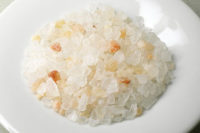Salt: French Fries That Satisfy
It benefits food manufacturers to understand how to optimize their ingredients, such as salt, to maximize the sensory performance in their products and realize potential cost savings.

Perhaps there’s never been a better time for a back-to-basics look at ingredient formulations. Food manufacturers not only face cost constraints but also proposed changes to the nutrition fact label. Then consider that brand-loyal consumers are sensitive to changes in sensory profile of the products they have grown to love.
That’s why it benefits food manufacturers to understand how to optimize their ingredients, such as salt, to maximize the sensory performance in their products and realize potential cost savings in their production.
Salt comes in many different particle sizes and shapes, each having a different physical attribute, such as adherence, solubility and bulk density. Taking a back-to-basics approach by understanding the physical attributes of the various types of salt can help food product developers design for optimal sensory performance, especially in topical snack applications such as potato chips and French fries.
In general, the larger the particle size and more cubic the shape, the greater the likelihood the salt will bounce off the surface of a snack product, which can lead to ingredient waste (cost implication) and less salty taste. To illustrate the effect of salt particle size and shape on adherence and sensory performance, Cargill compared table salt (large size and cubic in nature) and Alberger® Fine Flake (small size and cube agglomerate in shape) in a French fry application.
Table salt and Alberger® Fine Flake salt samples were salted to equivalent sodium content (~500 mg per 100 g French fry) and blindly presented to a sensory panel. The panel was asked to rate the level of saltiness (less, equivalent or more) of each sample compared to a reference French fry (table salt), which was also at the same sodium content.
The first observation noted by the Cargill food scientists was that it took twice as much table salt (3.2g salt per 680g frozen French fries) to achieve the same sodium content as the Alberger Fine Flake salt (1.6g salt per 680g frozen French fries). This suggest greater adherence with the Alberger Fine Flake salt and translates into less ingredient waste.
Considering the sensory test (“Just About Right for Saltiness”), 41.2% of the panel thought that the blind table salt sample was perceived as less salty than the reference (table salt) while 48.2% of the panel thought Alberger Fine Flake salt sample was more salty than the reference.
One possible explanation between the blind table salt and reference sample is the variability in the salt distribution on the French fry, due to the bouncing nature of the large, cube-shaped salt granule. The “more salty” result of the Alberger Fine Flake salt may be due to small, cube agglomerate shape of the crystals, which have greater solubility than the table salt.
Dr. Janice Johnson is a Cargill food scientist.
“It is believed that the quicker the salt crystal dissolves in the mouth, the greater the salty flavor burst or salty perception, and the sensory data generated in our French fry study would support this position,” she says.
Taking a back-to-basics approach by understanding the functional role of ingredients and ingredient attributes can help food product developers design or improve the sensory performance of their branded products to meet consumer expectations.
For more information:
Looking for a reprint of this article?
From high-res PDFs to custom plaques, order your copy today!





